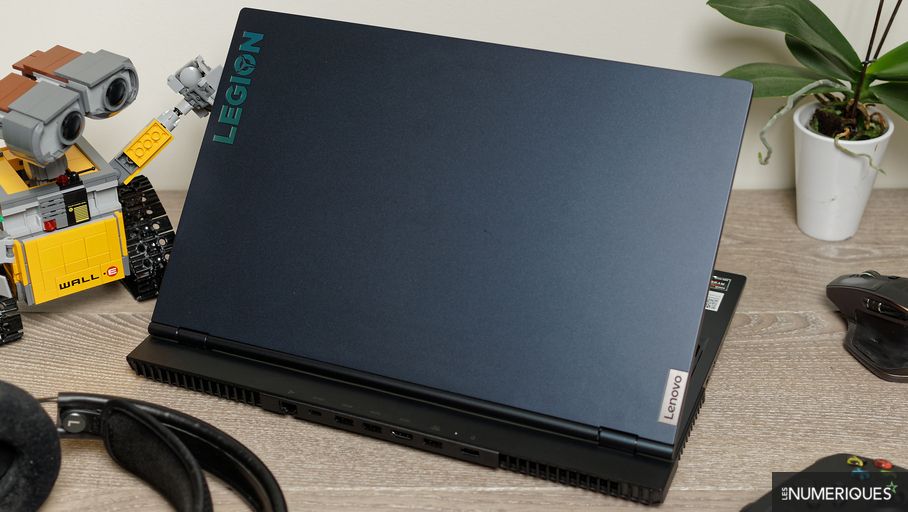The Lenovo Legion 5 has dark blue plastic on its screen cover, as well as plastic around the keyboard. The edges of the board are black particleboard, as is the bottom casing. The hinge is slightly developed on the frame or, depending on the point of view, the frame protrudes 3 cm behind the screen.
The iridescent effect of the Legion logo is very discreet, from white to blue to pink. © Digital
When you open the screen, the screen reveals a keyboard with a numeric keypad. The placement of the keys is relatively dense, but Lenovo made sure to move the arrow keys down. The keyboard is backlit on two levels and Fn-Space hotkeys between each mode. The writing quality is good and the keyboard does not suffer from any noticeable defect. The touchpad is a bit wider than the space bar and provides decent sliding and good feedback for left and right clicks. Middle clicking is relatively hard and does not allow dragging and dropping while maintaining pressure.
The Legion 5’s connectivity is particularly rich, with a USB Type-C port and a headphone/microphone combo jack on the left. To the right, Lenovo placed a USB 3.0 port, a switch for the webcam, and a light to turn on the computer. The latter is also duplicated with the start button above the keyboard and accompanied by an LED. Finally, between the two slots on the back of the chassis there are also three USB 3.0 ports, a proprietary-format charging jack, an HDMI 2.1 port, an RJ45 port and a USB Type-C port compatible with Power Delivery and DisplayPort.
Wireless connectivity is provided by an Intel AX201 chip that offers wifi 6 (2400 Mbit/s) and Bluetooth 5.2. The 720p webcam above the screen is again poor quality with a noticeable blur effect in the details.
Cooling is done by two fans blowing on four radiators located in the corners under the screen hinge. Lenovo allows changing the profile without going through the program using the keyboard shortcut FN-Q. Then the color of the start button changes according to the selected mode: blue for silent, white for automatic, red for turbo mode.
In turbo mode, we noticed a maximum temperature of 47.5 degrees Celsius between the arrow keys. ZQSD switches remain relatively cool with a temperature of 34°C. So the right side of the keyboard is the hottest part of the chassis, on top of the RTX 3060 and 130W TDP. The RTX 3060 slots are warmer (58.7 °C and 55.4 °C) than those of the Ryzen 7 5600H (52.2 °C and 50.2 °C).
Noise pollution is contained in silent mode with readings of 41 dB in the game. In automatic mode, the Legion 5 is heard slightly with 46 dB. However, we are in the middle of what laptops offer the games. In turbo mode, the Legion 5 is annoying with 50dB readings, causing draft Digital Notes from the neighbor’s office.
Note that the performance difference between auto and turbo mode is not specified. With the integrated standard ofAssassin’s Creed Valhalla, only 1 fps on average shares the two modes in favor of the turbo. This mode only makes it possible to better dissipate the calories generated by our processor graphics card pair.
Components are accessed by removing 10 Phillips screws. However, the structure is difficult to disassemble. We recommend that you start from the front with an old bank card or a specific instrument. The hardest part is the level of the holes that are cut tightly. It is enough to lift the casing to release all the back connections.
The interior of Lenovo Legion 5 without diffuser panels. © Digital
Once opened, there is a free M.2 site to the left under an aluminum plate that is held by three screws. Under the square aluminum plate are two DDR4 slots, one of which is occupied (we’ll come back to this later). Under the aluminum plate on the right is an SSD in M.2 format and a wifi card. The battery is not stuck and comes free after removing 4 screws. In passing, we will keep the empty space to the left of the battery. Lenovo could have taken the opportunity to expand the capacity of the latter from 60 watts to 80 or even 90 watts, as Asus does.
Lenovo equipped the Legion 5 with an IPS panel that displays 1920 x 1080 pixels at 120Hz, and incorporating it into the chassis wasn’t particularly keen because we measured a screen occupancy of 72%. However, this remains competitive at this point.
The Legion 5 panel doesn’t shine with its quality. We found a maximum brightness of 292 cd/m², an adequate value supported by the low reflectance of a matte coating with a light reflectance of 16%. By lowering the brightness to 200 cd/m² for color and autonomy measurements, we noticed that setting the brightness to 90% was sufficient. By lowering the degree to 80%, the brightness drops to only 100 cd/m²! Thus, light intensity below 80% is unusable. A better setting for this parameter would be welcome.
Contrast is rather low with a value of 1145:1. When using, black will be gray. The color temperature is 6262K, which is a value slightly lower than the video standard, but nothing prevents it. Finally, the panel does not present true colors since Delta-E’s peak at 6.8. As a reminder, chromatic drifts are imperceptible with a delta E of less than 3. For example, the slightly artificial green of our test pattern is almost khaki.
Good point for gamers, afterglow is only 15ms, which is a decent value for a laptop the games Which will not see lines on fast movements in the game.
From left to right, gamma curve, color temperature, and delta E. © Les Numériques

“Certified gamer. Problem solver. Internet enthusiast. Twitter scholar. Infuriatingly humble alcohol geek. Tv guru.”





